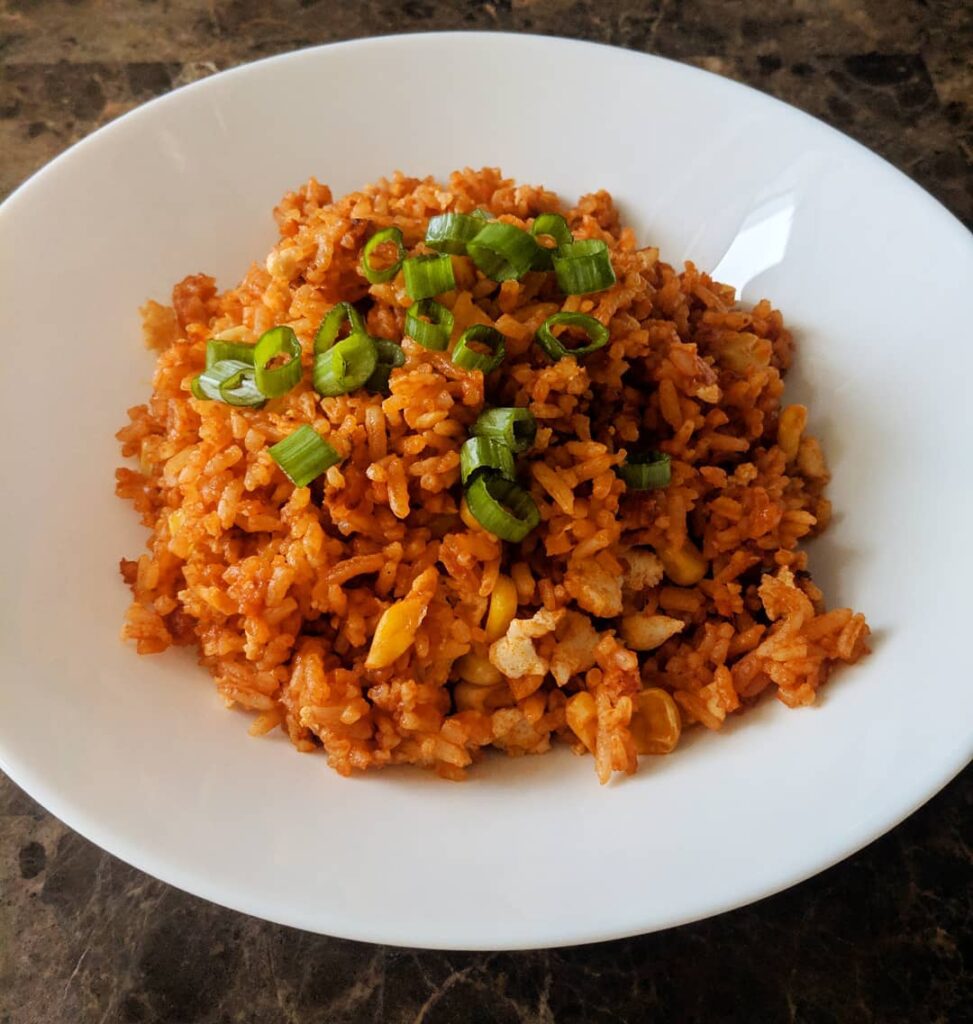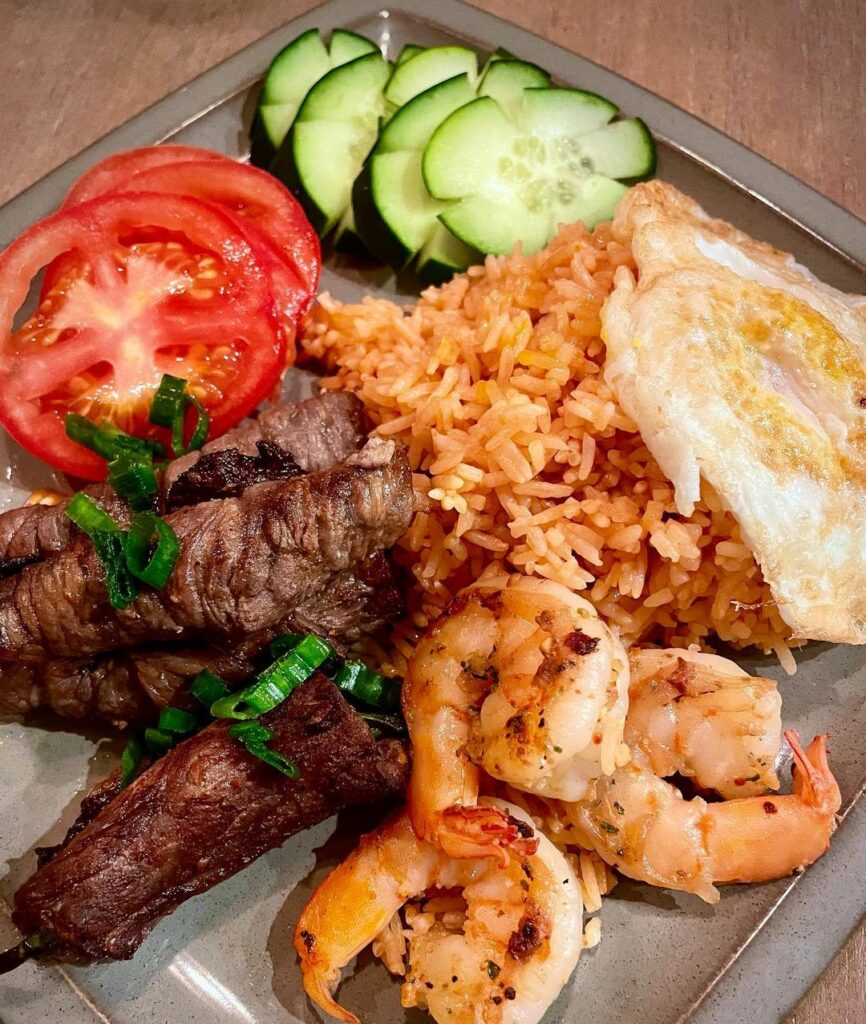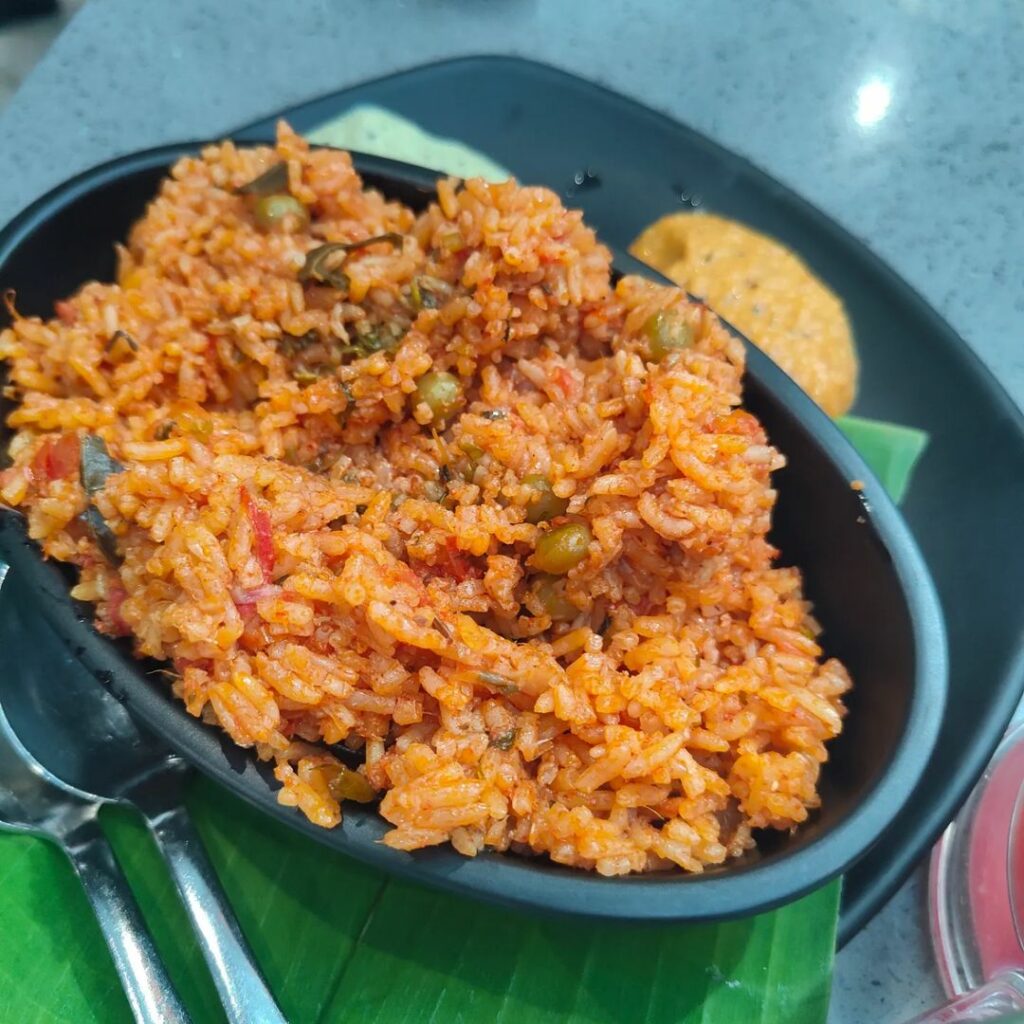During my travels to Vietnam, I discovered the ubiquitous dish known as Com Do, or red rice. The striking crimson hue and distinct nutty flavor immediately captivated me.
Beyond its stunning appearance and delicious taste, I learned that Com Do hold significant cultural and nutritional importance in Vietnamese cuisine.
From traditional preparations to modern fusion dishes, Com Do offer a unique and flavorful way to experience the essence of Vietnam.
Related: How To Make Vietnamese Fried Rice?
What is Com Do?

Com Do, or red rice, is a type of unpolished rice that is an essential part of Vietnamese cuisine. Its history can be traced back to ancient times, and it was traditionally served only to royalty due to its nutritional benefits.
Com Do is an important symbol of family values in Vietnamese culture and is often featured in important celebrations and rituals. It is believed to bring good luck and prosperity to those who consume it.
Today, Com Do is widely consumed throughout Vietnam and has gained popularity worldwide for its unique taste and nutritional benefits.
Com Do recipe

Soak the rice for at least 30 minutes before cooking.
Cooking note
- Yield: 4 servings
- Prep Time: 10 minutes
- Cook Time: 25–30 minutes
- Total Time: 35–40 minutes
- Course: Main dish
- Cuisine: Vietnamese
- Equipment: Rice cooker or a medium-sized pot with a tight-fitting lid
Ingredients
- 2 cups of rice
- 3 cups of water
- 1 tablespoon of vegetable oil
- 1 teaspoon of salt (optional)
How to cook Com Do?
Here’s a basic recipe for cooking Red Rice:
- Rinse the red rice in cold water until the water runs clear.
- Soak the rice in cold water for at least 30 minutes to an hour.
- Drain the water and add the rice to a rice cooker or a pot with a tight-fitting lid.
- Add 3 cups of water, 1 tablespoon of vegetable oil, and 1 teaspoon of salt (optional) to the rice.
- Stir well and cook on low heat for 25–30 minutes until the water is absorbed, and the rice is tender.
- Turn off the heat and let the rice rest for 5–10 minutes.
- Fluff the rice with a fork before serving.
Note: The cooking time and water ratio may vary depending on the type of Com Do and the cooking method. It’s best to follow the instructions on the package or adjust based on personal preference.
If you want to be simpler, you can still cook with a rice cooker
Cooking in a Rice Cooker: Drain the soaked rice and add it to the rice cooker. Add 3 cups of water and 1 tablespoon of vegetable oil. Turn on the rice cooker and let it cook for about 25-30 minutes or until the rice is tender.
In addition to the delicious Vietnamese Tomato Rice (Com Do), another beloved Vietnamese rice dish is Com Tam, which translates to ‘Broken Rice.’ Com Tam is a popular street food dish that features broken rice grains served with flavorful accompaniments such as grilled pork chops, shredded pork skin, and a fried egg. To explore more about this delightful dish, check out our article on Com Tam.
How to store Com Do?
To store cooked Com Do, follow these simple steps:
- Let the rice cool down to room temperature.
- Transfer the rice to an airtight container or a sealable plastic bag.
- Store the container in the refrigerator for up to 4–5 days.
- To reheat the rice, sprinkle a few drops of water over it and microwave for 1–2 minutes, or reheat it on the stovetop with a little bit of oil or water.
Note: It’s not recommended to store Com Do at room temperature for an extended period, as it can spoil quickly. Always store cooked rice in the refrigerator and consume it within a few days.
Tips for perfect Com Do
Here are some tips for cooking perfect Com Do:
- Soak the rice for at least 30 minutes before cooking to improve its texture and taste.
- Use a rice cooker or a pot with a tight-fitting lid to cook the rice evenly.
- Use the correct water ratio. Generally, the ratio of rice to water is 1:1.5 or 1:2 depending on the type of rice and the cooking method.
- Add a little bit of oil to the rice while cooking to prevent it from sticking to the bottom of the pot.
- Avoid lifting the lid or stirring the rice while it’s cooking, as it can disrupt the cooking process and affect the texture.
- Let the rice rest for a few minutes after cooking before fluffing it with a fork. This allows the rice to absorb any excess moisture and enhances the flavor.
- Use high-quality Com Do for the best results.
Nutritional benefits of Com Do
Com Do, or red rice, offers several nutritional benefits, including:
| Nutrient | Amount | Percent Daily Value |
| Calories | 368 | 18.4% |
| Protein | 7.5g | 15% |
| Carbohydrates | 77.3g | 25.8% |
| Fat | 2.8g | 4.3% |
| Fiber | 3.5g | 14% |
| Iron | 4.5 mg | 25% |
| Calcium | 10 mg | 1% |
| Magnesium | 143 mg | 36% |
- Antioxidants: Com Do is rich in antioxidants, which help to protect the body from free radical damage and reduce the risk of chronic diseases.
- High in Fiber: Com Do is high in fiber, which aids in digestion, reduces the risk of constipation, and helps to control blood sugar levels.
- Lowers Cholesterol: Com Do contains compounds that help to lower cholesterol levels in the blood, which can reduce the risk of heart disease.
- Rich in Iron: Com Do is an excellent source of iron, a mineral that is essential for the production of red blood cells and oxygen transport in the body.
- Other Nutritional Benefits: Com Do also contains vitamins and minerals such as vitamin B6, magnesium, and potassium, which are important for overall health.
Additionally, Com Do has been studied for its potential health benefits for certain conditions:
- Com Do and Diabetes: The high fiber content in Com Do may help to regulate blood sugar levels and improve insulin sensitivity, making it a good choice for those with diabetes.
- Com Do and Heart Health: The antioxidants and cholesterol-lowering compounds in Com Do can reduce the risk of heart disease and improve overall heart health.
- Com Do and Weight Loss: Com Do is a low-fat and low-calorie food that can help to promote weight loss when consumed in moderation as part of a healthy diet.
Com Do is a nutritious and healthy addition to any diet, offering several important health benefits for a variety of health conditions.
The different types of red rice

There are several different types of red rice available, each with their own unique characteristics and flavors. Here are five popular varieties:
- Traditional Red Rice: This is the original variety of Com Do, and it has a nutty flavor and a firm texture.
- Himalayan Red Rice: This type of red rice comes from the Himalayan region and has a soft texture and a sweet, nutty flavor.
- Thai Red Cargo Rice: This variety is commonly used in Thai cuisine and has a distinct flavor and aroma. It is rich in antioxidants and fiber.
- Bhutanese Red Rice: This rice is grown in the Himalayan Kingdom of Bhutan and has a nutty flavor and a slightly sticky texture.
- Forbidden Rice: This type of red rice gets its name from the ancient Chinese belief that only the emperor was allowed to eat it. It has a sweet, nutty flavor and a sticky texture.
Each type of red rice has its own unique taste and texture, making it an exciting ingredient to experiment with in the kitchen.
What to serve with Com Do?
Com Do pairs well with a variety of meat-based, seafood, and vegetable-based dishes. Here are some suggestions:
Meat-based dishes
- Grilled lemongrass chicken
- Braised pork belly with eggs
- Beef stir-fry with vegetables
- Vietnamese caramelized pork and eggs
- Chicken curry
Seafood dishes
- Garlic butter shrimp
- Sweet and sour fish
- Spicy squid stir-fry
- Grilled fish with herbs
- Seafood hotpot
Vegetable-based dishes
- Stir-fried vegetables with garlic and soy sauce
- Tofu and vegetable stir-fry
- Eggplant in clay pot
- Vegetarian
- Vietnamese-style mixed vegetable curry
Com Do also pairs well with a variety of sauces and condiments, such as fish sauce, chili sauce, pickled vegetables, and herbs like cilantro and mint. The possibilities for pairing Com Do with different dishes are endless, making it a versatile and delicious staple in Vietnamese cuisine.
Where to buy Com Do?

Red Rice can be found at many retailers, including:
- Asian specialty grocery stores: Many Asian grocery stores sell Red Rice, both in-store and online. Look for stores that specialize in Vietnamese or Southeast Asian products.
- Online retailers: There are a number of online retailers that sell Red Rice, making it easy for you to shop from the comfort of your home like Amazon and many other websites.
- Farmers Market: In some areas, farmers’ markets may sell Red Rice from local farmers. This is a great way to support small-scale farmers and get fresh, locally sourced produce.
When purchasing Red Rice, be sure to check the packaging for information on the type and origin of the rice, as well as any cooking instructions or nutritional information. Look for high-quality, sustainably produced Red Rice for the best flavor and nutritional benefits.
What is the price of a bag of red rice?
The price of a bag of Com Do can vary depending on the brand, type, and size of the package. On average, a 2-3 pound bag of high-quality Com Do can range from $5 to $15, depending on the retailer and location.
Organic or specialty varieties may be more expensive. Prices may also vary based on the region and availability of the product.
FAQs
How does red rice differ from white rice?
Com Do, or red rice, is a type of unpolished rice that has a reddish-brown color due to the presence of bran and germ.
White rice, on the other hand, is polished to remove the bran and germ, resulting in a whiter color and a softer texture.
Com Do has a nutty flavor and a chewy texture, while white rice is milder in flavor and softer in texture.
Is com gluten-free?
Yes, Com Do is gluten-free, making it a great option for those with gluten intolerance or celiac disease. However, it’s important to check the packaging to ensure that the rice has not been processed in a facility that also handles gluten-containing products.
Can Com Do be used in sushi?
Yes, Com Do can be used in sushi, although it has a different texture and flavor compared to traditional sushi rice. The nutty flavor and slightly chewy texture of Com Do can add a unique twist to sushi rolls.
It’s important to note that Com Do requires a longer cooking time and slightly more water than sushi rice, so adjustments may need to be made to the recipe.
Is red rice more expensive than white rice?
On average, red rice is slightly more expensive than white rice due to its unique flavor, texture, and nutritional benefits. However, the price can vary depending on the brand, type, and location of purchase.
Some specialty stores and online retailers may charge higher prices for organic or sustainably-produced red rice.
Is red rice good for digestion?
Red rice is a good source of fiber, which can help promote healthy digestion and prevent constipation. Fiber helps to move food through the digestive system, adding bulk to stools and aiding in regular bowel movements. Additionally, the high fiber content of red rice can help feed the beneficial bacteria in the gut, supporting overall gut health. So, incorporating red rice into your diet can be a great way to support healthy digestion.
How is red rice used in traditional Vietnamese cuisine?
Red rice, or Com Do, is a staple ingredient in traditional Vietnamese cuisine. It is often used as a side dish, accompanying meat, seafood, and vegetable dishes.
Com Do has a nutty flavor and a slightly chewy texture, making it a perfect complement to the bold and aromatic flavors of Vietnamese cuisine. In addition to its use as a savory side dish, red rice is also used in traditional Vietnamese sweet desserts, such as sweet red rice pudding.
It is a versatile ingredient that can be used in a variety of dishes, from simple comfort foods to complex and flavorful specialties.
Can red rice prevent heart disease?
Red rice is a good source of antioxidants and fiber, both of which can help reduce inflammation and lower cholesterol levels, which are risk factors for heart disease.
Some studies have suggested that consuming red rice may help lower the risk of heart disease, but more research is needed to confirm these findings. Nevertheless, incorporating red rice into a heart-healthy diet, alongside other nutritious foods, can be a beneficial step towards reducing the risk of heart disease.
What are some unique recipes that feature red rice?
Here are some unique recipes that feature red rice:
- Red Rice Salad: Cooked red rice is combined with chopped vegetables, nuts, and a tangy vinaigrette to make a refreshing and nutritious salad.
- Red Rice Porridge: Red rice is cooked with milk or coconut milk to make a creamy, sweet oatmeal that can be served as a breakfast or dessert.
- Red Rice Stuffed Peppers: Halved bell peppers are stuffed with a mixture of cooked red rice, vegetables, and spices, then baked until tender and flavorful.
- Red Rice Sushi: Red rice can be used as a substitute for white sushi rice to make colorful and nutritious sushi rolls.
- Red Rice Paella: Red rice is used as the base for a flavorful Spanish paella, featuring seafood, chicken, vegetables, and saffron.
- Red Rice Pilaf: Red rice is cooked with aromatic spices and vegetables to make a delicious and fragrant side dish.
- Red Rice Stir-Fry: Cooked red rice is stir-fried with vegetables, protein, and flavorful sauces for a quick and easy weeknight meal.
How many cups of rice per person?
The amount of rice per person for Vietnamese tomato rice can vary depending on individual appetite and serving sizes. As a general guideline, you can estimate approximately 1/2 to 3/4 cup of uncooked rice per person. This should yield a sufficient portion when cooked.
Conclusion
Overall, Com Do is a nutritious and versatile ingredient that has played an important role in Vietnamese cuisine and culture for centuries. Its unique flavor, texture, and nutritional benefits make it a great choice for anyone looking to add variety to their diet and improve their overall health.
From its use in savory side dishes to sweet deserts, Com Do has become a beloved staple in Vietnamese households and restaurants around the world. As demand for sustainable and healthy food options grows, Com Do is poised to continue to gain popularity among those seeking nutritious and flavorful alternatives to white rice.